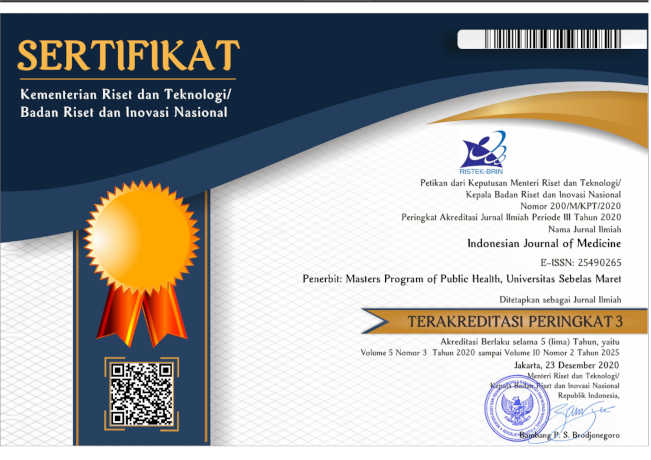Comparison of β-Hydroxylase Enzyme 11 Serum in Obese, Overweight, and Normoweight Young Men
DOI:
https://doi.org/10.26911/theijmed.2016.1.1.13Abstract
Background: Previous studies showed that cardiovascular risk factor was increased in obese and overweight subjects. Obesity and cardiovascular risk factor are associated with hypothalamic-pituitary-adrenal (HPA) axis hyperactivity that causes hypercortisolism, cortisol level is associated with cardiovascular risk factor on obesity. 11 β-hydroxylase is an enzyme that involved in cortisol synthesis. The aim of this study was to investigate 11 β-Hydroxylase concentration in obesity, overweight, and normal weight young men.
Subjects and Method: This was analytic-observational study using cross-sectional design. The study was conducted at HKBP Nommensen University, Medan. The study subjects included by 76 young men aged 18-28 years old, consisting of 25 obese subjects, 25 overweight, and 25 normoweight. The concentration of 11 β-Hydroxylase was evaluated in blood sample after 10 hours fasting. The data was analyzed bivariately.
Results: Mean of 11 β-Hydroxylase concentration was 52.76 ± 44.27 in obese subjects, 70.16 ± 46.83 in overweight subjects, and 43.42 ± 27.75 in normoweight subjects. The 11 β-Hydroxylase concentration in overweight subjects was statistically higher than normoweight subjects (p = 0.007), but the 11 β-Hydroxylase concentration on obese subjects statistically was not different from normoweight subjects (p = 0.362).
Conclusion: The 11 β-Hydroxylase concentration on overweight subject is higher than normoweight subject. There is no difference of 11 β-Hydroxylase concentration on obese and normoweight subject. Mitochondrial stress and mitochondrial failure mechanism on overweight and obesity merit further investigation.
Keywords: 11 β-Hydroxylase, cortisol, obesity, overweight
Correspondence: Jenny Novina Sitepu. Faculty of Medicine, HKBP Nommensen Medan University, Medan.
Indonesian Journal of Medicine (2016), 1(1): 71-75
https://doi.org/10.26911/theijmed.2016.01.01.09
References
Anagnostis P, Athyros VG, Tziomalos KA, Karagiannis, Mikhailids DP (2009). The pathogenetic role of cortisol in the metabolic syndrome: a hypothesis. J. Clin Endocrinol Metab. 94 (8): 2692-2701.
Andrabi SMS, Bhat MH, Andrabi SRS, Kamili MMA, A Imran, Nisar I (2013). Prevalence of metabolic syndrome in 8-18 year old school going children of srinagar city of kashmir india. Indian Journal of Endocrinology and Metabolism, 17: 95-100.
Barret K, Brooks H, Boitano S, Barman S (2010). Ganong's review of medical physiology 23th edition. USA: The McGraw Hill Companies, 337-90.
Humayun A, Shah AS, Alam S, Hussein H (2009). Relationship of body mass index and dyslipidemia in different age groups of male and female population of peshawar. J Ayub Med Coll Abbottabad 2009; 21 (2).
Inoue S, Zimmet P, Caterson I, Chunming C, Ikeda Y, Khalid AK, Kim YS, Basset J (2000). The asia pacific perspective: Redefining obesity and its treatment.WHO/WPR / Iaso/ IOTF [available from: http://www.wpro.who.int/ nutrition/documents/docs/Redefiningobesity.pdf?ua=1]. accessed 9 April 2014.
Juonala M, Magnussen CG, Berenson GS, Venn A, Burns TL, Sabin MA, Raitakari OT (2011). Childhood adiposity, adult adiposity, and cardiovascular riskfactors. N Engl J Med, 365: 1876-85.
Kaminski RM, Rogawski MA (2011). 11 β-hydroxylase inhibitors as protect againts seizures in mice by increasing endogenous neuroactive steroid synthesis. Neuropharmacology, 6(1):133-137.
Kargi AY, Iacobellis G (2014). Adipose tissue and adrenal glands: novel pathophysiological mechanism and clinical applications. International Journal of Endocrinology Volume 614 074 2014. ID.
McPhee SJ, Papadakis MA, Rabow MW. (2011). Current medical diagnosis and treatment, 15th edition. USA: McGraw Hill Companies, 1202-4.
Miller WL, Auchus RJ (2011). The molecular biology, biochemistry, and physiology of human steroidogenesis and its disorders. Endocrine reviews 32: 81-151, 2011.
Obregon MJ (2010). Maternal obesity results in offspring prone to metabolic syndrome. Journal of Endocrinology 151 (8): 3475-3476.
Prasad R, Kowalczyk JC, Meimaridou E, Storr HL, Metherell LA. (2014). Oxidative stress and adrenocortical insufficiency. Journal of Endocrinology. 221, R63-R73.
Prodam F, Ricotti R, Agarla V, Parlamento S, G Genoni, Balossini C, S Bellone (2013). High end normal adrenocorticotropic hormone and cortisol levels are associated with specific cardiovascular risk factors in pediatric obesity: a cross sectional study. BMC Medicine, 11:44.
Purnell JQ, Brandon DD, Isabelle LM, Loriaux DL, MH Samuels. (2004). Association of a 24-hour cortisol production rates, cortisol binding globulin, and plasma free cortisol levels with body composition, leptin levels, abd aging in adult men and women. J. Clin. Endocrinol. Metab, 89 (1): 281-287.
Ramzan M, Ali I, Ramzan F, Ramzan F, Ramzan MH (2011). Waist circumference and lipid profile Among primary school children. JPMI, 25(3): 222-226.
Basic Health Research (Riskesdas) (2013). Agency for Health Research and Development Ministry of Health of the Republic of Indonesia Year 2013 Jakarta: Ministry of Health of the Republic of Indonesia.
Rizk NM, Yousef M (2012). Association of lipid profile and waist circumference as cardiovascular risk factors for overweight and obesity Among school children in qatar. Diabetes, Metabolic Syndrome and Obesity: Targets and Therapy 2012: 5425-432.
Russel M, Bredella M, Tsai P, Miller KK, Klibanski A, Misra M (2009). Relative growth hormone and excess are associated with Increased cardiovascular risk markers in obese adolescents girls. J Clin Endocrinol Metab 94: 2864-2871.
Schmidt M, Johannesdottir SA, Lemeshow SA, Lash TL, Ulrichsen SP, Botker HE, Sorensen HT. (2013). Obesity in young men, and individual and combined risks of type 2 diabetes, cardiovascular morbidity and death before 55 years of age: danish 33-years follow-up study.
JS Thakur, Bisht S (2010). Comparative study of blood lipid profile of obese and non-obese sedentary college men. VSRD-TNTJ. Vol. I (1), 2010, 26-29
Tirosh A, Shai I, Afek A, Dubnov Raz G, Ayalon N, Gordon B, Rudich A. (2011). Adolescent bmi trajectory and risk of diabetes versus coronary disease. N Engl J Med 364: 1315-25.
World Health Organization. (2008). Waist Circumference and Waist-Hip Ratio; Report of a WHO Expert Consultation. Geneva: WHO.
World Health Organization (2011). Noncommunicable Diseases. Country Profiles. Geneva: WHO.
World Health Organization (2013). Global Health Statistics 2013 Part III. Global Health Indicators. Geneva: WHO.











